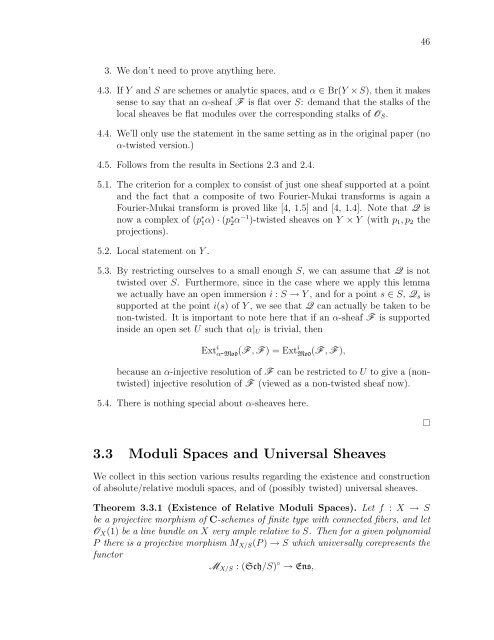derived categories of twisted sheaves on calabi-yau manifolds
derived categories of twisted sheaves on calabi-yau manifolds
derived categories of twisted sheaves on calabi-yau manifolds
You also want an ePaper? Increase the reach of your titles
YUMPU automatically turns print PDFs into web optimized ePapers that Google loves.
3. We d<strong>on</strong>’t need to prove anything here.<br />
4.3. If Y and S are schemes or analytic spaces, and α ∈ Br(Y × S), then it makes<br />
sense to say that an α-sheaf F is flat over S: demand that the stalks <str<strong>on</strong>g>of</str<strong>on</strong>g> the<br />
local <str<strong>on</strong>g>sheaves</str<strong>on</strong>g> be flat modules over the corresp<strong>on</strong>ding stalks <str<strong>on</strong>g>of</str<strong>on</strong>g> OS.<br />
4.4. We’ll <strong>on</strong>ly use the statement in the same setting as in the original paper (no<br />
α-<str<strong>on</strong>g>twisted</str<strong>on</strong>g> versi<strong>on</strong>.)<br />
4.5. Follows from the results in Secti<strong>on</strong>s 2.3 and 2.4.<br />
5.1. The criteri<strong>on</strong> for a complex to c<strong>on</strong>sist <str<strong>on</strong>g>of</str<strong>on</strong>g> just <strong>on</strong>e sheaf supported at a point<br />
and the fact that a composite <str<strong>on</strong>g>of</str<strong>on</strong>g> two Fourier-Mukai transforms is again a<br />
Fourier-Mukai transform is proved like [4, 1.5] and [4, 1.4]. Note that Q is<br />
now a complex <str<strong>on</strong>g>of</str<strong>on</strong>g> (p ∗ 1α) · (p ∗ 2α −1 )-<str<strong>on</strong>g>twisted</str<strong>on</strong>g> <str<strong>on</strong>g>sheaves</str<strong>on</strong>g> <strong>on</strong> Y × Y (with p1, p2 the<br />
projecti<strong>on</strong>s).<br />
5.2. Local statement <strong>on</strong> Y .<br />
5.3. By restricting ourselves to a small enough S, we can assume that Q is not<br />
<str<strong>on</strong>g>twisted</str<strong>on</strong>g> over S. Furthermore, since in the case where we apply this lemma<br />
we actually have an open immersi<strong>on</strong> i : S → Y , and for a point s ∈ S, Qs is<br />
supported at the point i(s) <str<strong>on</strong>g>of</str<strong>on</strong>g> Y , we see that Q can actually be taken to be<br />
n<strong>on</strong>-<str<strong>on</strong>g>twisted</str<strong>on</strong>g>. It is important to note here that if an α-sheaf F is supported<br />
inside an open set U such that α|U is trivial, then<br />
Ext i<br />
α-Mod(F , F ) = Ext i<br />
Mod(F , F ),<br />
because an α-injective resoluti<strong>on</strong> <str<strong>on</strong>g>of</str<strong>on</strong>g> F can be restricted to U to give a (n<strong>on</strong><str<strong>on</strong>g>twisted</str<strong>on</strong>g>)<br />
injective resoluti<strong>on</strong> <str<strong>on</strong>g>of</str<strong>on</strong>g> F (viewed as a n<strong>on</strong>-<str<strong>on</strong>g>twisted</str<strong>on</strong>g> sheaf now).<br />
5.4. There is nothing special about α-<str<strong>on</strong>g>sheaves</str<strong>on</strong>g> here.<br />
3.3 Moduli Spaces and Universal Sheaves<br />
We collect in this secti<strong>on</strong> various results regarding the existence and c<strong>on</strong>structi<strong>on</strong><br />
<str<strong>on</strong>g>of</str<strong>on</strong>g> absolute/relative moduli spaces, and <str<strong>on</strong>g>of</str<strong>on</strong>g> (possibly <str<strong>on</strong>g>twisted</str<strong>on</strong>g>) universal <str<strong>on</strong>g>sheaves</str<strong>on</strong>g>.<br />
Theorem 3.3.1 (Existence <str<strong>on</strong>g>of</str<strong>on</strong>g> Relative Moduli Spaces). Let f : X → S<br />
be a projective morphism <str<strong>on</strong>g>of</str<strong>on</strong>g> C-schemes <str<strong>on</strong>g>of</str<strong>on</strong>g> finite type with c<strong>on</strong>nected fibers, and let<br />
OX(1) be a line bundle <strong>on</strong> X very ample relative to S. Then for a given polynomial<br />
P there is a projective morphism MX/S(P ) → S which universally corepresents the<br />
functor<br />
MX/S : (Sch/S) ◦ → Ens,<br />
46
















